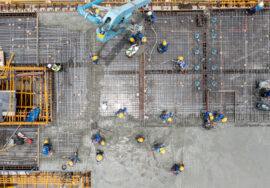
Construction Project Management vs. Architecture
Construction Project Management vs. Architecture: Key Differences and Roles
Introduction
Construction Project Management vs Architecture: Construction project management (CPM) and architecture are two crucial disciplines in the construction industry, each with distinct responsibilities and expertise. While both professionals contribute significantly to the development of buildings, their roles, focus areas, and objectives differ. Understanding the differences between construction project management and architecture is essential for ensuring the success of any construction project.
Defining Construction Project Management
Construction project management involves overseeing the planning, coordination, and execution of a construction project from start to finish. A construction project manager is responsible for managing timelines, resources, budgets, and ensuring quality control throughout the construction process. The goal is to deliver a project on time, within budget, and in compliance with industry standards and client expectations.
Defining Architecture
Architecture focuses on the design and aesthetics of buildings and structures. Architects create blueprints and design plans that consider both the functional and artistic aspects of a building. Their role involves balancing creativity with practicality, ensuring the building’s design meets both the client’s vision and structural requirements.
Key Differences Between Construction Project Management and Architecture
1. Focus and Objectives
The primary difference between CPM and architecture is the focus of each profession. Construction project management is focused on the execution and management of the project, ensuring that all processes run smoothly and efficiently. CPM aims to meet project deadlines, budgets, and quality standards.
Architecture, on the other hand, is concerned with the design of the building. Architects focus on the aesthetics, functionality, and sustainability of a structure. Their goal is to create visually appealing and structurally sound designs that meet the client’s needs while adhering to zoning laws, building codes, and environmental considerations.
2. Project Phases
In CPM, the construction project manager is involved throughout the entire project lifecycle, from initial planning to project completion. They oversee various phases, including budgeting, resource allocation, scheduling, procurement, and risk management. CPM focuses on ensuring the project progresses according to plan and resolves any issues that may arise during construction.
Architects, however, are typically involved in the earlier phases of the project. Their work begins with conceptual design, followed by detailed design development and creating construction documents. While architects remain involved during construction to ensure that their designs are executed correctly, their primary contribution is in the design phase.
3. Technical Skills vs. Creative Skills
Construction project managers require strong technical and organizational skills. They need to manage multiple aspects of the project, including budgets, resources, and timelines, while also coordinating with contractors, suppliers, and laborers. Project managers often use construction software and project management tools to track progress and ensure efficiency.
Architects, on the other hand, require a combination of creative and technical skills. They must have a strong understanding of design principles, building materials, and construction methods while also being creative enough to develop innovative and functional designs. Architects also use specialized software like AutoCAD or Revit to produce detailed design drawings.

4. Risk Management and Problem Solving
In CPM, risk management and problem-solving are central responsibilities. Construction projects can face a range of challenges, from delays and budget overruns to unforeseen technical issues. Project managers must have the ability to assess risks, develop mitigation strategies, and solve problems in real-time to keep the project on track.
For architects, problem-solving is more focused on design challenges, such as balancing aesthetics with functionality, working within spatial constraints, and adhering to regulatory requirements. Architects must ensure that their designs are feasible, safe, and comply with building codes.
5. Interaction with Stakeholders
Construction project managers work closely with various stakeholders throughout the entire project, including clients, architects, contractors, suppliers, and subcontractors. They act as the central coordinator, ensuring that communication flows smoothly between all parties and that everyone is aligned with the project goals.
Architects primarily interact with clients and other design professionals during the design phase. They may also collaborate with engineers, landscape architects, and interior designers to ensure that their design vision is implemented correctly. During the construction phase, architects may conduct site visits to ensure that the construction is following the approved design.
Similarities Between Construction Project Management and Architecture
1. Collaboration with Clients
Both CPM and architecture require close collaboration with clients. In CPM, the project manager ensures that the client’s expectations are met throughout the construction process, managing resources to align with the project goals. Architects work directly with clients to understand their vision and translate it into a practical design that meets both aesthetic and functional needs.
2. Regulatory Compliance
Both CPM and architecture must ensure compliance with local regulations, building codes, and safety standards. In CPM, the project manager ensures that all aspects of the construction project meet regulatory requirements and legal standards. Architects also play a key role by designing buildings that adhere to zoning laws, safety regulations, and environmental standards.
3. Project Success
Both CPM and architecture are essential to the success of a construction project. Without effective project management, a well-designed building may face delays, budget overruns, or quality issues. Similarly, without thoughtful architectural design, the final structure may not meet the client’s needs or expectations.
Conclusion
While construction project management and architecture are distinct disciplines, they work hand in hand to ensure the success of a construction project. CPM focuses on the logistical, financial, and operational aspects of project execution, while architecture is centered around creative design and functionality. Both roles are critical in transforming a client’s vision into a completed, well-executed building.
For construction project management services, contact us.
External Links:
- Learn more about the role of architects at American Institute of Architects.
- Explore construction project management best practices at Project Management Institute.








